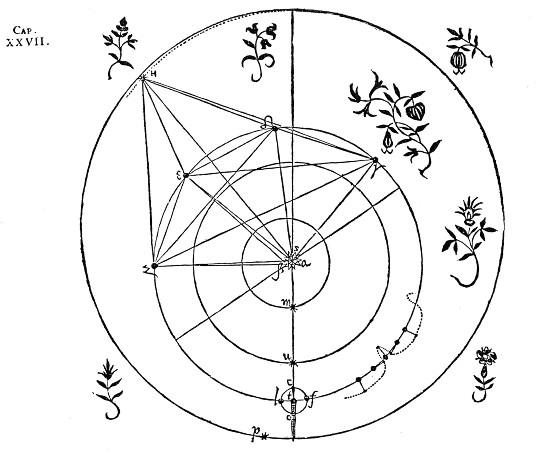Johannes Kepler (1571–1630) became a supporter of Copernicus’ heliocentric theory thanks to Michale Maestlin, who introduced him to the arcana of astronomy at the University of Tübingen.
In 1596 Kepler published Mysterium Cosmographicum (The Secret of the Universe), a spirited apology of Copernicus’s system, in which he combined the system of six planetary orbits (of Mercury, Venus, Earth, Mars, Jupiter, and Saturn) with six Platonic solids.
In the centre of this system was located the Sun, which was to be the source of the force that sets the planets in motion. At that time it was a revolutionary idea, since astronomy, including that of Copernicus, was grounded on description of the paths of planet with the use of uniform circular motions, given to planetary orbs ‘by nature’. In other words, astronomy was then geometry. From 1600, when Kepler began to work with Tycho Brahe, he searched for parameters of the orbits of Mars and Earth, which were presented with the use of traditional circles and, what is more, were related to the mathematical point called an average Sun and not the true Sun.
But after Brahe’s death, Kepler returned to the idea of planetary motions influenced by the physical action of the Sun. He compared the position of planets to the true Sun and determined that they move not in circles, but in oval curves. Eventually in 1605 he discovered that the orbit of Mars is an ellipse (Kepler’s first law). And this shape, according to Kepler, results from the interaction between a planet and the magnetic emanation radiating from the rotating Sun. The scientist assumed that this influence is inversely proportional to the distance of a planet from the Sun.
On this basis he proved his second law: during equal intervals of time, a planet’s radius vector, that is a line joining a planet with the Sun, sweeps out equal areas. Kepler thus formed physical astronomy, a matter difficult to accept in his time both by astronomers and by philosophers, and presented the first description of it in 1609 in his work entitled Astronomia Nova, the full title of which is the New Astronomy, Based upon Causes, or Celestial Physics, Treated by Means of Commentaries on the Motions of the Star Mars, from the Observations of Tycho Brahe. His third law, which links the period of circulation of a planet with the size of its orbit, Kepler discovered later, in 1618, and published in his work Harmonice mundi (The Harmony of the World, 1619).
Further reading:
- Stephenson, Kepler’s Physical Astronomy (New York, 1987).
- M. Swerdlow, Astronomy in the Renaissance, "Astronomy before the telescope", ed. by C. Walker (London, 1996), 187–230.
 English (United Kingdom)
English (United Kingdom)  Polski (PL)
Polski (PL) 






